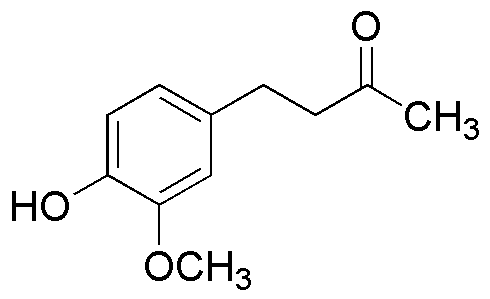Vanillylacetone is widely utilized in research focused on various practical applications across multiple industries:
- Flavoring Agent: Commonly used in the food industry, it enhances the flavor profile of products like baked goods and beverages, providing a sweet, vanilla-like taste.
- Fragrance Component: In cosmetics and personal care products, it serves as a fragrance ingredient, contributing to pleasant scents in perfumes, lotions, and soaps.
- Pharmaceutical Applications: It has potential uses in medicinal formulations due to its antioxidant properties, which may help in developing health supplements.
- Research in Sensory Studies: Employed in sensory research to study taste and smell, aiding in the development of new flavor profiles and fragrance formulations.
- Natural Insect Repellent: Investigated for its effectiveness as a natural insect repellent, offering an eco-friendly alternative to synthetic chemicals in pest control products.
General Information
Properties
Safety and Regulations
Applications
Vanillylacetone is widely utilized in research focused on various practical applications across multiple industries:
- Flavoring Agent: Commonly used in the food industry, it enhances the flavor profile of products like baked goods and beverages, providing a sweet, vanilla-like taste.
- Fragrance Component: In cosmetics and personal care products, it serves as a fragrance ingredient, contributing to pleasant scents in perfumes, lotions, and soaps.
- Pharmaceutical Applications: It has potential uses in medicinal formulations due to its antioxidant properties, which may help in developing health supplements.
- Research in Sensory Studies: Employed in sensory research to study taste and smell, aiding in the development of new flavor profiles and fragrance formulations.
- Natural Insect Repellent: Investigated for its effectiveness as a natural insect repellent, offering an eco-friendly alternative to synthetic chemicals in pest control products.
Documents
Safety Data Sheets (SDS)
The SDS provides comprehensive safety information on handling, storage, and disposal of the product.
Product Specification (PS)
The PS provides a comprehensive breakdown of the product’s properties, including chemical composition, physical state, purity, and storage requirements. It also details acceptable quality ranges and the product's intended applications.
Certificates of Analysis (COA)
Search for Certificates of Analysis (COA) by entering the products Lot Number. Lot and Batch Numbers can be found on a product’s label following the words ‘Lot’ or ‘Batch’.
*Catalog Number
*Lot Number
Certificates Of Origin (COO)
This COO confirms the country where the product was manufactured, and also details the materials and components used in it and whether it is derived from natural, synthetic, or other specific sources. This certificate may be required for customs, trade, and regulatory compliance.
*Catalog Number
*Lot Number
Safety Data Sheets (SDS)
The SDS provides comprehensive safety information on handling, storage, and disposal of the product.
DownloadProduct Specification (PS)
The PS provides a comprehensive breakdown of the product’s properties, including chemical composition, physical state, purity, and storage requirements. It also details acceptable quality ranges and the product's intended applications.
DownloadCertificates of Analysis (COA)
Search for Certificates of Analysis (COA) by entering the products Lot Number. Lot and Batch Numbers can be found on a product’s label following the words ‘Lot’ or ‘Batch’.
*Catalog Number
*Lot Number
Certificates Of Origin (COO)
This COO confirms the country where the product was manufactured, and also details the materials and components used in it and whether it is derived from natural, synthetic, or other specific sources. This certificate may be required for customs, trade, and regulatory compliance.


